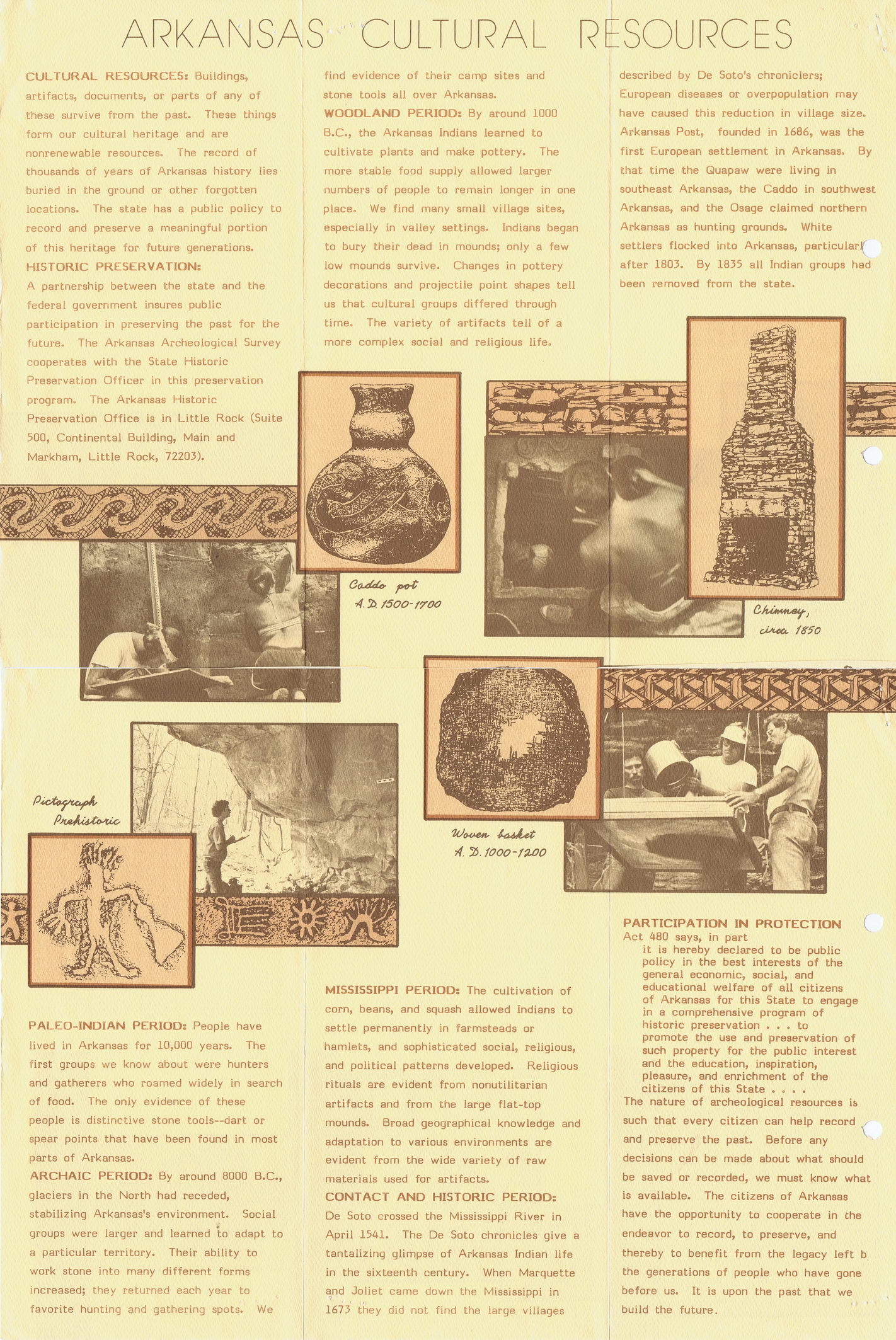This text was obtained via automated optical character recognition.
It has not been edited and may therefore contain several errors.
CULTURAL RESOURCES: Buildings, artifacts, documents, or parts of any of these survive from the past. These things form our cultural heritage and are nonrenewable resources. The record of thousands of years of Arkansas history lies buried in the ground or other forgotten locations. The state has a public policy to record and preserve a meaningful portion of this heritage for future generations. HISTORIC PRESERVATION: A partnership between the state and the federal government insures public participation in preserving the past for the future. The Arkansas Archeological Survey cooperates with the State Historic Preservation Officer in this preservation program. The Arkansas Historic Preservation Office is in Little Rock (Suite 500, Continental Building, Main and Markham, Little Rock, 72203). find evidence of their camp sites and stone tools all over Arkansas. WOODLAND PERIOD: By around 1000 B.C., the Arkansas Indians learned to cultivate plants and make pottery. The more stable food supply allowed larger numbers of people to remain longer in one place. We find many small village sites, especially in valley settings. Indians began to bury their dead in mounds; only a few low mounds survive. Changes in pottery decorations and projectile point shapes tell us that cultural groups differed through time. The variety of artifacts tell of a more complex social and religious life. described by De Soto's chroniclers; European diseases or overpopulation may have caused this reduction in village size. Arkansas Post, founded in 1686, was the first European settlement in Arkansas. By that time the Quapaw were living in southeast Arkansas, the Caddo in southwest Arkansas, and the Osage claimed northern Arkansas as hunting grounds. White settlers flocked into Arkansas, particular^ after 1803. By 1835 all Indian groups had been removed from the state. PALEO-INDIAN PERIOD: People have lived in Arkansas for 10,000 years. The first groups we know about were hunters and gatherers who roamed widely in search of food. The only evidence of these people is distinctive stone tools—dart or spear points that have been found in most parts of Arkansas. ARCHAIC PERIOD: By around 8000 B.C., glaciers in the North had receded, stabilizing Arkansas's environment. Social * groups were larger and learned to adapt to a particular territory. Their ability to work stone into many different forms increased; they returned each year to favorite hunting and gathering spots. We MISSISSIPPI PERIOD: The cultivation of corn, beans, and squash allowed Indians to settle permanently in farmsteads or hamlets, and sophisticated social, religious, and political patterns developed. Religious rituals are evident from nonutilitarian artifacts and from the large flat-top mounds. Broad geographical knowledge and adaptation to various environments are evident from the wide variety of raw materials used for artifacts. CONTACT AND HISTORIC PERIOD: De Soto crossed the Mississippi River in April 1541. The De Soto chronicles give a tantalizing glimpse of Arkansas Indian life in the sixteenth century. When Marquette and Joliet came down the Mississippi in 1673 they did not find the large villages PARTICIPATION IN PROTECTION ( Act 480 says, in part it is hereby declared to be public policy in the best interests of the general economic, social, and educational welfare of all citizens of Arkansas for this State to engage in a comprehensive program of historic preservation ... to promote the use and preservation of such property for the public interest and the education, inspiration, pleasure, and enrichment of the citizens of this State .... The nature of archeological resources is such that every citizen can help record ^ \ and preserve the past. Before any decisions can be made about what should be saved or recorded, we must know what is available. The citizens of Arkansas have the opportunity to cooperate in the endeavor to record, to preserve, and thereby to benefit from the legacy left b the generations of people who have gone before us. It is upon the past that we build the future.

Native Americans Arkansas-Archeological-Survey-(1)